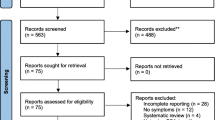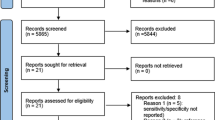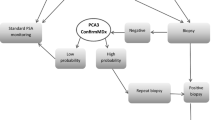Summary
Background
There is now evidence that the advantages of screening for prostate cancer based only on prostate specific antigen (PSA) are probably offset by the health and economic disadvantages arising from over-diagnosis and over-treatment. Among novel and promising biomarkers, attention has recently been focused on the PSA isoform p2PSA, alone or in combination with free PSA (as %p2PSA), and in combination with total and free PSA as the prostate health index (phi).
Methods
We performed an electronic search for original articles published in English, French, Spanish and Italian reporting studies that assessed the diagnostic performance of %p2PSA for prostate cancer screening in direct comparison with PSA, using the keywords “Prostate Cancer”, and “Measurement” or “Screening”, and “proPSA” or “p2PSA” or “[-2]proPSA”. Titles, abstracts and full texts were carefully read, and articles not matching the inclusion criteria were excluded. Heterogeneity was evaluated by the I-squared test. The pooled estimates of accuracy and the resulting area under the receiver operator characteristic curve (AUC) were calculated using a random effect model.
Results
On the basis of the electronic search, 11 articles and 12 studies, including a total of 5,139 subjects (2,338 with prostate cancer) and with modest heterogeneity (Isquared, 66%) were selected. The %p2PSA pooled estimates were always greater than those of PSA, and so was the cumulative pooled AUC (0.687 versus 0.538; p<0.001). The diagnostic odds ratio was more than double for %p2PSA than for total PSA (4.0 versus 1.7). With a sensitivity of 0.95, routine p2PSA testing may result in up to 10% fewer unnecessary biopsies than the use of PSA for screening. The AUC of phi was slightly but not significantly better than that of %p2PSA (0.736 versus 0.717; p=0.21).
Conclusions
These findings provide a rationale for planning further studies to assess whether %p2PSA testing may generate more favourable outcomes in terms of mortality and quality of life. Direct comparison does not permit the conclusion that the phi is globally superior to %p2PSA for detecting prostate cancer.
Riassunto
Premesse
È stato dimostrato che i benefici dello screening del cancro prostatatico con l’antigene prostatico specifico (PSA) sono probabilmente superati da svantaggi clinici ed economici, soprattutto relativi a un eccesso di diagnosi e interventi terapeutici. Tra i vari biomarcatori, l’isoforma p2PSA del PSA ha focalizzato molta attenzione negli ultimi anni, sia usata da sola, oppure come %p2PSA in combinazione con PSA libero, o come Prostate Health Index (phi), in combinazione con il PSA totale e libero.
Metodi
Abbiamo eseguito una ricerca elettronica per articoli originali pubblicati in inglese, francese, spagnolo e italiano, che hanno studiato le prestazioni diagnostiche di %p2PSA per lo screening del tumore della prostata in confronto diretto con PSA, utilizzando le parole chiave “Prostate Cancer”, e “Measurement” o “Screening”, e “proPSA” o “p2PSA” o “[-2]proPSA”. Titolo, riassunto e testo sono stati attentamente letti e gli articoli non corrispondenti ai criteri d’inclusione sono stati esclusi. L’eterogeneità è stata valutata mediante test di I-quadrato. Le stime cumulative delle performance e l’area sotto la curva (AUC) mediante analisi receiver operator characteristic (ROC) sono state calcolate in base ad un modello ad effetto casuale.
Risultati
Undici articoli e dodici studi, per un totale di 5.139 soggetti (2.338 con cancro prostatico) e con modesta eterogeneità (I-quadrato: 66%) sono stati selezionati. Le performance diagnostiche di %p2PSA sono sempre risultate superiori a quelle del PSA, cosÌ come l’AUC cumulativa (0,687 versus 0,538; p <0,001). La diagnostic odds ratio è doppia per %p2PSA rispetto a PSA totale (4,0 versus 1,7). Alla sensibilità di 0,95, l’esecuzione routinaria del p2PSA può risparmiare fino al 10% di biopsie non necessarie rispetto al PSA. L’AUC del phi non è superiore ma non significativamente migliore di quella del %p2PSA (0,736 versus 0,717; p = 0,21).
Conclusioni
Questi risultati forniscono una base razionale ad ulteriori studi volti a valutare se l’uso del %p2PSA può generare risultati più favorevoli in termini di mortalità e qualità della vita. Il confronto diretto non permette invece di concludere che phi sia globalmente superiore a p2PSA% per lo screening del cancro della prostata.
Similar content being viewed by others
References
Siegel R, Naishadham D, Jemal A (2012) Cancer statistics, 2012. CA Cancer J Clin 62:10–29
Centro Nazionale di Epidemiologia, Sorveglianza e Promozione della Salute. I numeri del cancro in Italia 2011. http://www.epicentro.iss.it/temi/tumori/italiaEpid.asp. Accessed 27 October 2012
Brooks DD, Wolf A, Smith RA et al (2010) Prostate cancer screening 2010: updated recommendations from the American Cancer Society. J Natl Med Assoc 102:423–429
Chou R, Croswell JM, Dana T et al (2011) Screening for prostate cancer: a review of the evidence for the U.S. Preventive Services Task Force. Ann Intern Med 155:762–771
Heidenreich A, Bellmunt J, Bolla M et al (2011) EAU guidelines on prostate cancer. Part 1: screening, diagnosis, and treatment of clinically localised disease. Eur Urol 59:61–71
Sciarra A, Cattarino S, Gentilucci A et al (2011) Update on screening in prostate cancer based on recent clinical trials. Rev Recent Clin Trials 6:7–15
Carlsson S, Vickers AJ, Roobol M et al (2012) Prostate cancer screening: facts, statistics, and interpretation in response to the US Preventive Services Task Force Review. J Clin Oncol 30:2581–2584
Wilt TJ, Brawer MK, Jones KM et al (2012) Prostate Cancer Intervention versus Observation Trial (PIVOT) Study Group Radical prostatectomy versus observation for localized prostate cancer. N Engl J Med 367:203–213
Heijnsdijk EA, Wever EM, Auvinen A et al (2012) Quality-of-life effects of prostate-specific antigen screening. N Engl J Med 367:595–605
Greene KL, Albertsen PC, Babaian RJ et al (2009) Prostate specific antigen best practice statement: 2009 update. J Urol 182:2232–2241
Lippi G, Montagnana M, Guidi GC, Plebani M (2009) Prostatespecific antigen-based screening for prostate cancer in the third millennium: useful or hype? Ann Med 41:480–489
Lippi G (2011) Re: Jean-Nicolas Cornu, Géraldine Cancel-Tassin, Valérie Ondet et al. Olfactory detection of prostate cancer by dogs sniffing urine: a step forward in early diagnosis. Eur Urol 2011;59:197–201. Eur Urol 60:e29
Zhang MZ, Lu YP (2012) From pro-prostate specific antigen, [-2]pro-prostate specific antigen to Beckman Coulter phi: the evolution of new biomarkers for early detection of prostatic carcinoma. Chin Med J (Engl) 125:1643–1649
Whiting P, Rutjes AW, Reitsma JB et al (2003) The development of QUADAS: a tool for the quality assessment of studies of diagnostic accuracy included in systematic reviews. BMC Med Res Methodol 3:25
Higgins JP, Thompson SG, Deeks JJ, Altman DG (2003) Measuring inconsistency in meta-analyses. BMJ 327:557–560
Catalona WJ, Bartsch G, Rittenhouse HG et al (2003) Serum pro prostate specific antigen improves cancer detection compared to free and complexed prostate specific antigen in men with prostate specific antigen 2 to 4 ng/ml. J Urol 170(6 Pt 1):2181–2185
Mikolajczyk SD, Catalona WJ, Evans CL et al (2004) Proenzyme forms of prostate-specific antigen in serum improve the detection of prostate cancer. Clin Chem 50:1017–1025
Catalona WJ, Bartsch G, Rittenhouse HG et al (2004) Serum proprostate specific antigen preferentially detects aggressive prostate cancers in men with 2 to 4 ng/ml prostate specific antigen. J Urol 171(6 Pt 1):2239–2244
Sokoll LJ, Wang Y, Feng Z et al (2008) [-2]proenzyme prostate specific antigen for prostate cancer detection: a National Cancer Institute Early Detection Research Network validation study. J Urol 180:539–543
Stephan C, Kahrs AM, Cammann H et al (2009) A [-2]proPSAbased artificial neural network significantly improves differentiation between prostate cancer and benign prostatic diseases. Prostate 69:198–207
Jansen FH, van Schaik RH, Kurstjens J et al (2010) Prostate-specific antigen (PSA) isoform p2PSA in combination with total PSA and free PSA improves diagnostic accuracy in prostate cancer detection. Eur Urol 57:921–927
Sokoll LJ, Sanda MG, Feng Z et al (2010) A prospective, multicenter, National Cancer Institute Early Detection Research Network study of [-2]proPSA: improving prostate cancer detection and correlating with cancer aggressiveness. Cancer Epidemiol Biomarkers Prev 19:1193–1200
Le BV, Griffin CR, Loeb S et al (2010) [-2]Proenzyme prostate specific antigen is more accurate than total and free prostate specific antigen in differentiating prostate cancer from benign disease in a prospective prostate cancer screening study. J Urol 183:1355–1359
Guazzoni G, Nava L, Lazzeri M et al (2011) Prostate-specific antigen (PSA) isoform p2PSA significantly improves the prediction of prostate cancer at initial extended prostate biopsies in patients with total PSA between 2.0 and 10 ng/ml: results of a prospective study in a clinical setting. Eur Urol 60:214–222
Catalona WJ, Partin AW, Sanda MG et al (2011) A multicenter study of [-2]pro-prostate specific antigen combined with prostate specific antigen and free prostate specific antigen for prostate cancer detection in the 2.0 to 10.0 ng/ml prostate specific antigen range. J Urol 185:1650–1655
Perdonà S, Bruzzese D, Ferro M et al (2012) Prostate health index (phi) and prostate cancer antigen 3 (PCA3) significantly improve diagnostic accuracy in patients undergoing prostate biopsy. Prostate. doi: 10.1002/pros.22561. [Epub ahead of print]
Stenner E, Micheli W, Bussani A et al (2008) Comparison of Hybritech and WHO standardization applied to access Hybritech total PSA assay on UniCel®. RIMeL/IJLaM 4:43–46
Schröder FH, Hugosson J, Roobol MJ et al (2012) ERSPC Investigators Prostate-cancer mortality at 11 years of follow-up. N Engl J Med 366:981–990
Naya Y, Fritsche HA, Bhadkamkar VA et al (2005) Evaluation of precursor prostate-specific antigen isoform ratios in the detection of prostate cancer. Urol Oncol 2005;23:16–21
Liang Y, Ankerst DP, Ketchum NS et al (2001) Prospective evaluation of operating characteristics of prostate cancer detection biomarkers. J Urol 185:104–110
Isharwal S, Makarov DV, Sokoll LJ et al (2011) ProPSA and diagnostic biopsy tissue DNA content combination improves accuracy to predict need for prostate cancer treatment among men enrolled in an active surveillance program. Urology 77:763.e1–e6
Blanchet JS, Houlgatte A, Durand X et al (2010) The [-2]proPSA and the Prostate Health Index (phi) improve the detection of prostate cancer for patients with total PSA between 1.8 and 8.0 ng/mL. J Mens Health 7:345
Blanchet JS, Durand X, Houlgatte A et al (2010) The Beckman Coulter prostate health index (phi) increases the specificity of detection of prostate cancer and reduces the number of negative biopsies. J Mens Health 7:346
Blanchet JS, Vincendeau S, Durand X et al (2010) Detection of aggressive prostate cancer using [-2]proPSA and the prostate health index. J Mens Health 7:346
Vincendeau S, Ramirez J, Durand X et al (2010) The Beckman Coulter prostate health index (phi) improves diagnostic accuracy in prostate cancer detection. Eur Urol Suppl 9:309
Houlgatte A, Vincendeau S, Desfemmes F et al (2012) Use of [-2] pro PSA and phi index for early detection of prostate cancer: a prospective of 452 patients. Prog Urol 22:279–283
Ferro M, Bruzzese D, Perdonà S et al (2012) Predicting prostate biopsy outcome: prostate health index (phi) and prostate cancer antigen 3 (PCA3) are useful biomarkers. Clin Chim Acta 413:1274–1278
Nichol MB, Wu J, Huang J et al (2012) Cost-effectiveness of Prostate Health Index for prostate cancer detection. BJU Int 110:353–362
Nichol MB, Wu J, An JJ et al (2011) Budget impact analysis of a new prostate cancer risk index for prostate cancer detection. Prostate Cancer Prostatic Dis 14:253–261
Ceriotti F, Postillo M, Fasoli L, Dorigatti F (2011) Pre-analytical phase of [-2]proPSA measurement and Prostate Health Index calculation. Biochim Clin 35:373–376
Semjonow A, Köke T, Eltze E et al (2010) Pre-analytical in-vitro stability of [-2]proPSA in blood and serum. Clin Biochem 43:926–928
Tadtayev S, McNicholas TA, Boustead GB (2012) Re: Giorgio Guazzoni, Massimo Lazzeri, Luciano Nava et al. Preoperative prostate-specific antigen isoform p2PSA and its derivatives, %p2PSA and Prostate Health Index, predict pathologic outcomes in patients undergoing radical prostatectomy for prostate cancer. Eur Urol 2012;61:455–66. Eur Urol 62:e14-e15
Lippi G, Aloe R, Cervellin G (2011) p2PSA but not total and free PSA increases after myocardial infarction: results of a preliminary investigation. Int J Cardiol 153:119
Sokoll LJ, Chan DW, Klee GG et al (2012) Multi-center analytical performance evaluation of the Access Hybritech immunoassay. Clin Chim Acta 413:1279–1283
Author information
Authors and Affiliations
Corresponding author
Rights and permissions
About this article
Cite this article
Lippi, G., Aloe, R. & Mattiuzzi, C. Prostate-specific antigen (PSA) isoform p2PSA in prostate cancer screening: systematic review of current evidence and further perspectives. Riv Ital Med Lab 8, 231–238 (2012). https://doi.org/10.1007/s13631-012-0067-7
Received:
Accepted:
Published:
Issue Date:
DOI: https://doi.org/10.1007/s13631-012-0067-7




